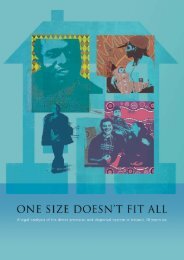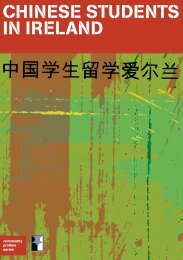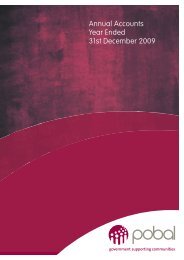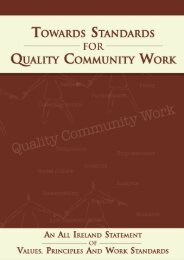Intercultural Education in the Post-Primary School - National Council ...
Intercultural Education in the Post-Primary School - National Council ...
Intercultural Education in the Post-Primary School - National Council ...
You also want an ePaper? Increase the reach of your titles
YUMPU automatically turns print PDFs into web optimized ePapers that Google loves.
new language when <strong>the</strong>y want and need tocommunicate, when <strong>the</strong>y are learn<strong>in</strong>g with<strong>the</strong>ir peers, when <strong>the</strong>y are engaged <strong>in</strong> ageappropriateactivities and when learn<strong>in</strong>gnew <strong>in</strong>formation and new skills stimulates<strong>the</strong>m. In some <strong>in</strong>stances plac<strong>in</strong>g a newstudent with his/her peers may not suit<strong>the</strong> student’s needs at this time, forexample when his/her peers are <strong>in</strong> anexam<strong>in</strong>ation class.SUPPORTING SECOND LANGUAGE LEARNING INTHE MAINSTREAM CLASSROOMIntroduc<strong>in</strong>g <strong>the</strong> newcomer student on entry<strong>in</strong>to <strong>the</strong> classIt is important when <strong>the</strong> student enters <strong>the</strong>class for <strong>the</strong> first time that reference ismade to her or his language ability <strong>in</strong> apositive way. For example, he/she might be<strong>in</strong>troduced as Thierry who speaks Frenchfluently, has a little English and is learn<strong>in</strong>gIrish, ra<strong>the</strong>r than say<strong>in</strong>g this that is Thierryand he doesn’t speak English or Irish.Many students who don’t speak <strong>the</strong>language of <strong>in</strong>struction (i.e. Irish orEnglish) may speak a number of languagesfluently, and it is important that <strong>the</strong> factthat <strong>the</strong>y do not speak <strong>the</strong> language of<strong>in</strong>struction is not seen as hav<strong>in</strong>g languagedifficulties. Empathy for <strong>the</strong> student’ssituation can be developed through mak<strong>in</strong>greference to <strong>the</strong> fact that most students arelearn<strong>in</strong>g ei<strong>the</strong>r Irish or English as a secondlanguage and that it is not always easy toparticipate <strong>in</strong> a class that is not conductedthrough our first language. O<strong>the</strong>r studentsshould be encouraged to be supportive oflanguage learners and to allow <strong>the</strong>m timeto develop <strong>the</strong>ir second language skills,without mak<strong>in</strong>g fun of <strong>the</strong>m when <strong>the</strong>ymake mistakes.Students can also be encouraged to activelysupport language learners, by be<strong>in</strong>g madeaware that <strong>the</strong>y can help language learnersunderstand <strong>the</strong> language of <strong>the</strong> classroom.Students <strong>the</strong>mselves may come up withsome great ideas as to how <strong>the</strong>y cansupport <strong>the</strong>ir language-learn<strong>in</strong>g classmates,particularly if it is put <strong>in</strong> <strong>the</strong> context ofwhat would help <strong>the</strong>m if <strong>the</strong>y had to takepart <strong>in</strong> a geography class or maths classthrough a second language (for example,ei<strong>the</strong>r English or Irish, as appropriate).The classroom as a language classroomTeachers are not only teachers ofgeography or maths, but <strong>the</strong>y are alsolanguage teachers and <strong>the</strong>ir classrooms arelanguage classrooms.The most important th<strong>in</strong>g <strong>the</strong> classroomteacher can do for <strong>the</strong> learner of a secondlanguage is to demonstrate a positiveattitude towards language and l<strong>in</strong>guisticdiversity and communicate this to <strong>the</strong>o<strong>the</strong>r students <strong>in</strong> <strong>the</strong>ir class. Teachers whof<strong>in</strong>d <strong>the</strong>mselves <strong>in</strong> this situation for <strong>the</strong>first time, may f<strong>in</strong>d it very daunt<strong>in</strong>g and alittle overwhelm<strong>in</strong>g, but <strong>the</strong>re are somesimple steps that <strong>the</strong> classroom teacher cantake to create a classroom environmentthat is supportive of <strong>the</strong> second languagelearner.Planned programme of supportStudents learn<strong>in</strong>g through a secondlanguage need a planned programme ofsupport on entry <strong>in</strong>to <strong>the</strong> post-primaryschool. This will <strong>in</strong>volve co-operativeplann<strong>in</strong>g between subject teachers, <strong>the</strong>language support teacher and <strong>the</strong> parents.The effectiveness of this language supportcan be maximised by giv<strong>in</strong>g priority tolanguage that will allow learners to access<strong>the</strong> curriculum. It is also important to notethat newly-arrived students for whom <strong>the</strong>language of <strong>in</strong>struction is not <strong>the</strong>ir firstlanguage may go through a silent periodwhile <strong>the</strong>y are adjust<strong>in</strong>g to <strong>the</strong> newenvironment.108<strong>Intercultural</strong> <strong>Education</strong> <strong>in</strong> <strong>the</strong> <strong>Post</strong>-<strong>Primary</strong> <strong>School</strong>
















